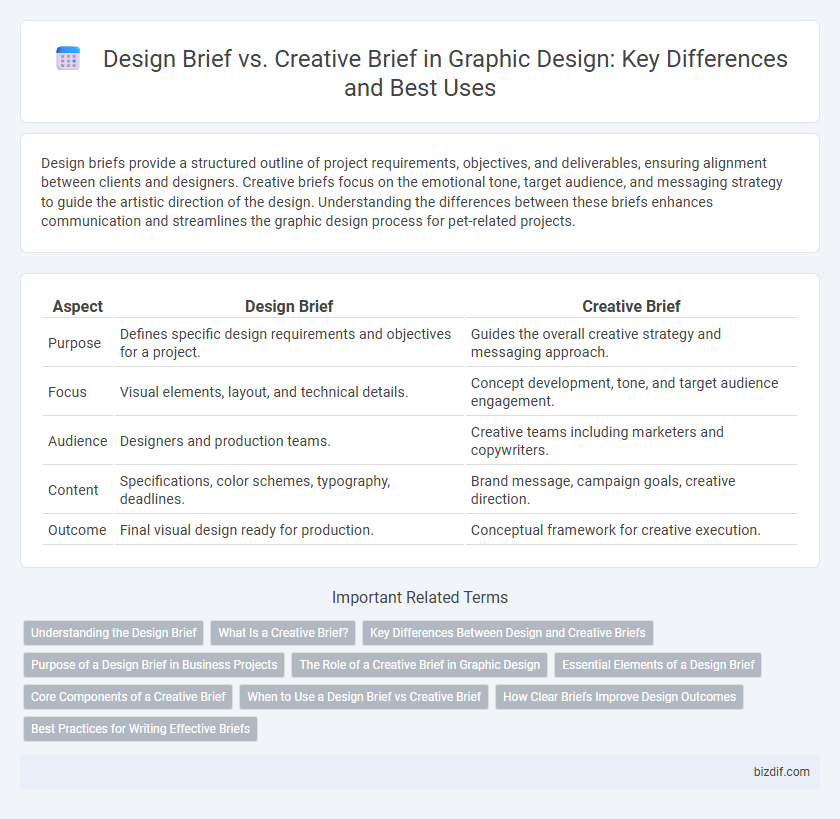Design briefs provide a structured outline of project requirements, objectives, and deliverables, ensuring alignment between clients and designers. Creative briefs focus on the emotional tone, target audience, and messaging strategy to guide the artistic direction of the design. Understanding the differences between these briefs enhances communication and streamlines the graphic design process for pet-related projects.
Table of Comparison
| Aspect | Design Brief | Creative Brief |
|---|---|---|
| Purpose | Defines specific design requirements and objectives for a project. | Guides the overall creative strategy and messaging approach. |
| Focus | Visual elements, layout, and technical details. | Concept development, tone, and target audience engagement. |
| Audience | Designers and production teams. | Creative teams including marketers and copywriters. |
| Content | Specifications, color schemes, typography, deadlines. | Brand message, campaign goals, creative direction. |
| Outcome | Final visual design ready for production. | Conceptual framework for creative execution. |
Understanding the Design Brief
A design brief provides specific project requirements, goals, and constraints essential for guiding the design process, focusing on deliverables, target audience, and technical details. Understanding the design brief ensures alignment between client expectations and the designer's execution, streamlining communication and workflow. It differs from a creative brief by emphasizing practical details over broader creative strategies and messaging.
What Is a Creative Brief?
A creative brief is a strategic document that outlines the key objectives, target audience, messaging, and deliverables for a graphic design project, ensuring alignment between clients and designers. It serves as a foundation for the creative process by providing clear guidelines on tone, style, and brand identity. Unlike a design brief, which often focuses on technical aspects and project scope, a creative brief emphasizes the emotional and conceptual elements driving the design.
Key Differences Between Design and Creative Briefs
Design briefs primarily focus on the technical specifications, project scope, target audience, and deliverables required for a visual design project, while creative briefs emphasize the overarching vision, messaging, tone, and brand identity to inspire creative direction. Design briefs provide concrete guidelines such as color schemes, dimensions, and file formats, whereas creative briefs guide conceptual storytelling, emotional engagement, and innovative ideas. Understanding these key differences ensures clarity between production requirements and creative inspiration in graphic design projects.
Purpose of a Design Brief in Business Projects
A design brief in business projects serves as a foundational document that outlines the project's objectives, target audience, scope, and deliverables to ensure alignment between stakeholders and designers. It provides clear guidelines and constraints, facilitating efficient decision-making and resource allocation throughout the design process. This strategic framework helps achieve desired outcomes by maintaining focus on business goals and client expectations.
The Role of a Creative Brief in Graphic Design
A creative brief serves as a vital roadmap in graphic design, outlining project objectives, target audience, brand guidelines, and key messaging to ensure cohesive visual communication. It translates client goals into actionable design strategies, fostering alignment between designers and stakeholders throughout the creative process. This focused document enhances efficiency, creativity, and consistency, ultimately driving impactful design solutions that resonate with the intended audience.
Essential Elements of a Design Brief
A design brief outlines the project's objectives, target audience, deliverables, budget, and timeline, serving as a foundational blueprint for the design process. Essential elements include clear project goals, client expectations, brand guidelines, and technical specifications to ensure alignment and efficiency. Differing from a creative brief, which emphasizes messaging and creative direction, the design brief focuses on practical and strategic requirements critical to successful project execution.
Core Components of a Creative Brief
A creative brief centers on key components such as project objectives, target audience, brand messaging, tone of voice, and desired outcomes to guide the design process effectively. Unlike a design brief, which often outlines technical specifications and deliverables, a creative brief emphasizes strategic insights that inspire creativity and align stakeholder expectations. Clear articulation of these core elements ensures a cohesive and impactful graphic design outcome.
When to Use a Design Brief vs Creative Brief
A design brief is used when outlining specific project goals, technical requirements, and deliverables for visual design tasks such as branding, web design, or packaging. A creative brief is ideal during the initial stages of a campaign or marketing project to capture the target audience, messaging strategy, and creative direction. Choosing between a design brief and creative brief depends on whether the focus is on execution details or strategic communication objectives within the graphic design process.
How Clear Briefs Improve Design Outcomes
Clear design briefs and creative briefs provide precise project goals, target audiences, and key deliverables that align client expectations with designers' workflows. Well-defined briefs minimize revisions by establishing a shared understanding of branding, tone, and style, enhancing efficiency and consistency in the final output. This clarity accelerates decision-making and fosters innovative yet focused design solutions that effectively communicate the intended message.
Best Practices for Writing Effective Briefs
A design brief focuses on project-specific details such as objectives, target audience, deliverables, and technical requirements, ensuring clear alignment with business goals. In contrast, a creative brief emphasizes the overarching vision, tone, messaging, and emotional impact to inspire creative teams and guide concept development. Best practices for writing effective briefs include clarity, conciseness, precise objectives, well-defined target demographics, and collaboration between stakeholders to ensure consistency and purpose throughout the design process.
Design brief vs Creative brief Infographic

 bizdif.com
bizdif.com